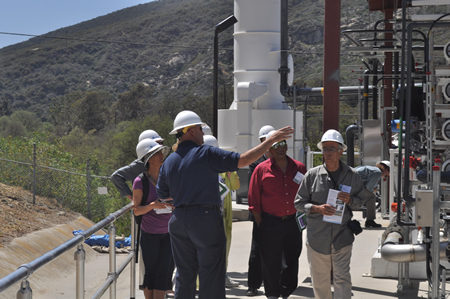
Thanks to the acknowledged efforts of a local waterman for pressing local authorities to clean the creek water spilling onto Aliso Beach, the ribbon was officially cut on a water reclamation facility in Aliso Canyon last week.
If creek levels allow, the $2.8 million Aliso Creek Water Reclamation Facility will be able to divert 400 gallons of water a minute flowing in Aliso Creek from inland communities due to run-off, preventing that much contaminant-laden water from running into the sea.
Contamination signs frequently sprout around the creek mouth on Aliso Beach to warn beachgoers from entering polluted water, with a beach closure even this week due to a sewage spill from upstream Laguna Hills.
The new facility’s ability to pull water out of the creek will reduce contaminants entering the sea, said John Langill, superintendent of operations at South Coast Water District, which owns the new facility. Brine, a salty by-product of the new filtration system, will now be diluted with treated wastewater to meet government standards and then discharged through the district’s existing outfall pipe, 1.5 miles from the shoreline off Aliso Beach.
At the ceremony, South Laguna resident Mike Beanan received credit from the top ranks of the once-resistant water district for a 15-year campaign to divert contaminated creek water. He beamed as he stood before his hard-won dream in the form of pipes, tanks, pumps and filtered water. The new facility is located next to the district’s coastal sewage treatment plant in Aliso Canyon and is surrounded by the Aliso and Wood Canyons Wilderness Park.
“The motivation is we have one of the best oceans in the world right here,” said Beanan, a water-quality activist and South Laguna Civic Association member. “We just had whales at the mouth of the creek. If there’s anything we can do as a community to reduce the pollution, that’s good.”
Beanan was once considered a “pesky pest” for pressuring local officials to clean up polluted Aliso Creek, former Laguna Beach Mayor Jane Egly said from the podium at the event. He was finally taken seriously by the water district in 2008. “No one wanted to be responsible for the water in the creek,” Beanan said.
Diverted creek water, which in dry weather originates from urban runoff, is blended with water filtered through sand at the existing sewage treatment plant. The plant already stores recycled water to meet current needs of irrigation customers. At the new facility, the water is further filtered and cleaned by reverse osmosis, which removes antibiotics, pesticides, solids and metal ions, and, most notably reduces the salinity level to prevent burning grassy landscapes, explained Steve Dishon, water production supervisor. Chlorine is added to kill any bacteria before the water is reused for irrigation.
When there’s not enough creek water, stored treated wastewater will be sent through the new saline-lowering filtering system if needed for recycled-water customers. Last year, the water district produced 728,000 gallons of recycled water from its sewage treatment facility on a per-need basis for customers.
The high salinity of the existing recycled water was a drawback to some landscape customers, including nearby Aliso Creek Golf Course, which uses 16.3 million gallons of drinking water a year to irrigate its greens, said Linda Homscheid, a water district spokeswoman. Mark Christy, the golf course’s new owner, agreed to switch from potable water “sometime this year,” to the low-saline irrigation water, she said.
“The new recycled water supply is more irrigation-friendly, particularly for grassy areas and golf-course greens,” Andy Brunhart, the district’s general manager, said to an audience of 75, which included South Laguna Civic Assn. members, past and present elected officials, regulators, local environmentalists and water district personnel.
As an ocean swimmer, Beanan had noticed that the water near the mouth of Aliso Creek was unusually green due to algae blooms. Algae blooms can create what is known as red tide, which blocks sunlight from reaching kelp beds critical to ocean health. “It was obviously from fertilizer run-off in the creek,” he said.
The newly diverted water will be used on landscaping for commercial customers. The district’s top recycled water buyer, the Monarch Beach Golf Links, pays $3.62 for each unit of 748 gallons of water, said Homscheid, who declined to disclose its total water usage. Montage resort, Niguel Shores Homeowners’ Assn., the cities of Laguna Beach and Dana Point and the St. Regis Resort are also customers.
State regulations prohibit the water district from lowering creek flow below 34.42 gallons per second. “If the creek’s over that, we can take water out of there,” said Langill. “Everything we take out of the creek will reduce that much impact to the ocean water. And then everything we recycle is less water leaving the sewage treatment plant going to the ocean.”
Designing the facility began in January 2013 and was partly funded by a $500,000 state grant administered through the south county watershed area and a $25,000 grant from Laguna Beach. The remainder came from water district reserves, said Homscheid.





[…] Plant Prevents Runoff from Reaching the Sea […]
Hhhhmmmmm…Aliso Creek Golf Course gulps 16.5 MILLION GALLONS of drinkable water each year to keep the greens green???? That’s equal to the average annual consumption of 45,000 people a YEAR! More than the populace of Laguna Beach-YIKES. And the freeway signs announce California’s severe drought…….and we are asked to conserve…it is a shame Laguna strives for the accolade of being most water wise, yet allows this wasteful process to continue.
The Aliso Creek Golf Course now uses “new water” from the Urban Runoff Recovery Facility. More recycled water means less is discharged as secondary sewage to the ocean outfall. More recycled water reduces and conserves demand for potable, drinking water. Water wise is achieved using more recycled water and less drinking water to irrigate Laguna.